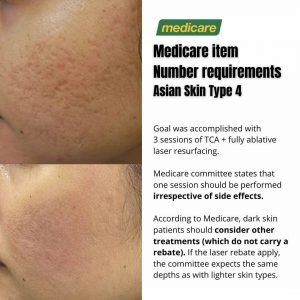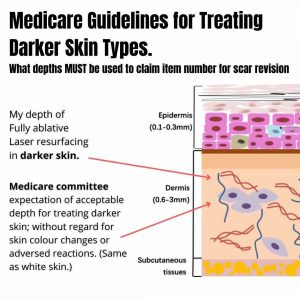Laser Resurfacing Acne Scars At A Glance
- Best Results1 session
- Treatment Recovery7-10 days
- Procedure Time60 minutes
- Skin SpecialistDavin Lim
- Duration of ResultsPermanent
- AnaestheticSedation
- Back to Work5-9 days
- Cost$$-$$$
Laser Resurfacing Acne Scars
Fully ablative laser resurfacing is an excellent treatment for superficial acne scars in the correct skin type. One resurfacing procedure can reduce the appearance of acne scars by up to 98%. I employ both CO2 & erbium lasers for this job.
FactsLaser Resurfacing Acne Scars; Fully Ablative Lasers
- Most skin types can be treated with fully ablative lasers
- Darker skin patients must be treated more conservatively
- Superficial scars respond best to fully ablative procedures
- Healing typically takes 7+ days
What is fully ablative laser resurfacing
Laser Resurfacing Acne Scars
This procedure is an old fashioned way of treating acne scars. It is still relevant in today’s age of fractional lasers & radiofrequency microneedling devices. Ablative lasers include the CO2 and erbium lasers. They specifically target water within the skin.
Unlike fractional lasers & energy devices such as radiofrequency microneedling, fully ablative resurfacing removes 100% of the skin’s surface area. They are best employed for the treatment of superficial acne scars.
How is this different from fractional lasers?
Fractional lasers such as Fraxel, Pixel, Edge, eCO2, Mixto & many others deliver laser beams to a percentage of the skin’s surface. Approximately 5-60% of the surface area is treated with fractional lasers. In contrast, fully ablative laser resurfacing treats 100% of the skin’s surface.
| Laser Type | Number of treatments | Recovery | Indication |
| Fractional | 2-6 | 2-5 days | Multiple levels of Acne scarring |
| Fully Ablative | One | 7+ days | Scars in the same Horizontal plane |
What types of scars can be treated with this procedure?
Dr Davin Lim has developed the Clarity Program for treating darker skin types. This addresses collagen, clarity & colour for the treatment of ethnic and Asian skin types. This program
Fully ablative CO2 & or erbium laser resurfacing should only be performed when the majority of scars lie within the same plane. Think of this procedure as sanding the floor, the deepest scratches are treated before sanding.
Boxcar scars, pits, shallow ice picks & mild to moderate rolling acne scars are examples that respond best to fully ablative resurfacing.
address the 3 most important aspects of skin rejuvenation with utmost safety and efficacy.
We employ Pico lasers & the 1927 Thulium wavelength to treat pigment, improve skin texture, and decrease wrinkles. Unlike IPL or other lasers, this program is a gentle but effective as it targets both superficial pigment & deeper collagen.
What types of acne scars can not be treated with this procedure?
Significant atrophic & tethered scars as well as deep ice pick scars do not respond well to fully ablative lasers. The latter requires procedures to raise them up prior to full ablation. The former requires methods such as surgical subcision.


View our Treatment Gallery
What is the meaning of ‘rate limiting scars?’
This refers to the most difficult scars to treat. Everyone will have different scars that limit the effectiveness of scar directed procedures. These scars should be addressed early on in the revision process as they are the last to respond.
Most often, rate limiting scars are the deepest scars, or the scars with the most amount of volume deficits.

patient ethnic skin type, & the depth of boxcar acne scars. This dictates the pace of treatment.
Can this laser be used on all skin types & colours?
Fully ablative lasers in the context of full resurfacing can be used on skin types 1 to 4. I do not treat Indian, African American or Sri Lankan patients with full resurfacing due to the risks of hypopigmentation (loss of pigment).
Skin type 5-6 patients are far better off with conservative lasers or RFM.
Why do I use two types of lasers for this procedure?
3 reasons- safety, recovery & depth of penetration. By using erbium lasers as the first pass, it provides added safety with less skin colour changes compared to CO2 lasers alone. Recovery can also be sped up with erbium laser – as compared to the same depth achieved with CO2 lasers.
Thirdly, depth of penetration. If I am required to go deeper than the highest setting on the erbium, I use the Ultrapulse CO2. This allows me to add 2-3 mm past the point of fully ablative erbium lasers.

Does ablative laser resurfacing hurt?
This procedure is done under sedation. Additionally I use numbing gel, nerve blocks & skin cooling. These measures are taken to ensure that laser resurfacing is well tolerated.

How long will it take to heal up from this procedure?
Skin starts to heal by the end of day 6-7. Yours skin will be completely re-epithelialized (meaning barrier function is established) within 8-10 days. After this you can wear makeup or tinted sunscreen.
The definition of healing up does not include skin colour changes. This may take 3-12 weeks to settle down, depending on your skin colour as well as the depth of resurfacing.
Are there any side effects?
Side effects are uncommon, & can be largely mitigated with close follow up. Unlike fractional resurfacing, the entire surface of the skin is vapourized with laser-much like a thermal burn. Side effects include-
- Infection – 2-3% of cases. Easily identified & treated providing follow ups are adhered to.
- Skin colour changes extending beyond 3 months. Temporary skin colour changes are not side effects, they are part of the healing up process.
- Acne like lesions are seen in 12-15% of cases. This is temporary & mostly due to the occlusive ointments post laser surgery.
- Scarring is extremely uncommon. More common on the jawline areas. Occurs in less than 1% of cases.
What are the other options?
Fully ablative laser resurfacing plays a small role in the overall management of acne scars. Manual methods including TCA Paint, surgical subcision as well as other energy devices play an important role. For every fully ablative procedure, I am treating 20 more with less invasive lasers & or procedures.
Other commonly used scar revision techniques include fractional lasers, microneedling, RFM (radiofrequency microneedling), nano RF & chemical peels.
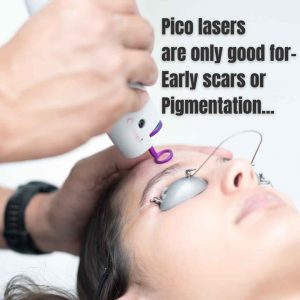
How much does this procedure cost?
Costing depends on the complexity of scarring. In Australia this procedure can be subsidised by Medicare (unlike treatments such as RF microneedling & fractional lasers).
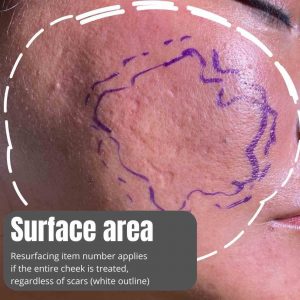

The caveat is that the entire cosmetic unit requires treatment, meaning that for resurfacing has to be extended to non-scared areas (ridiculous). Additionally, Medicare has stipulated that if fully ablative lasers are employed, other treatments such as fractional lasers can not be used.
For darker skin types, the level of ablation has to approach that of lighter skin types, irrespective of side effects before the treatment is subsidised.

Fully ablative resurfacing is performed by myself & not my clinical nurses.
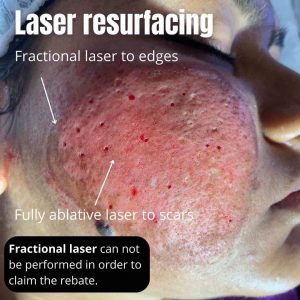
What should I consider before undergoing this procedure?
Fully ablative resurfacing is a big deal. It essentially is a full thickness controlled burn of your face, reaching the mid-dermal layers. Things to consider prior to the procedure include-
- Downtime & recovery: 7 days minimum. Usually a few more weeks of redness, & in darker skin types, post inflammatory hyperpigmentation.
- Follow ups: are mandatory to reduce complications & side effects. On average 2-4 visits over the duration of healing. These follow ups are done primarily by my clinical team.
- Cost: most cases were subsidies by Medicare however the recent change in 2022 has changed the rebate requirements.

Though the item number description meets the way I lase, Medicare stipulates that depth of ablative lasers should be equal in all skin types.
Davin’s Viewpoint on Laser Resurfacing
Still a relevant procedure in today’s age of fractional devices. I probably do 2-3 cases a week for acne scars, & an additional 3 more for wrinkles, sun damage & cosmetic concerns.
In the context of acne scars, it is important to raise up the scars to the highest point possible prior to resurfacing. This decreases side effects & downtime but also improves overall outcome. For lighter skin types, expect redness for a few weeks post procedure. This can be treated with vascular lasers or BBL.
Darker skin types may experience PIH or skin darkening post procedure. This can be treated with pico or nano lasers.
Fully ablative laser resurfacing can be safely combined with other scar directed treatments such as subcision, TCA CROSS & RF microneedling.
The recent changes in Medicare requirements essentially rules out laser resurfacing as a subsidised procedure for darker skin types. Lighter skin patients can be treated with fully ablative laser, however the entire cosmetic unit must be treated- regardless of scarred areas, an example are the cheeks. For darker skin patients, the exception is that to claim an item number, the resurfacing depths must be equal to lighter skin types. Hence their recommendations to pursue treatments that have no Medicare rebate- examples include RF microneedling, Fractional non-ablative lasers.